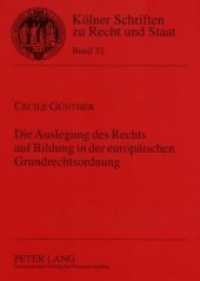- ホーム
- > 洋書
- > ドイツ書
- > Humanities, Arts & Music
- > History
- > miscellaneous
Description
(Short description)
Briefe waren in der Zeit vor der Erfindung des Telefons zentral für die Kommunikation und sind bis heute eine faszinierende Quelle für die Forschung. Anders als heute war der Anteil der Privatbriefe sehr hoch. Bei denjenigen, die regelmäßig Briefe schrieben, waren fünf bis zehn pro Tag keine Seltenheit. Das Buch behandelt Spezifika und Rahmenbedingungen der Briefkommunikation seit der Aufklärung, greift Impulse aus der Historischen Netzwerkforschung auf und reflektiert die Bedeutung von Briefen für die Erforschung des 19. Jahrhunderts.
(Text)
Briefe waren in der Zeit vor der Erfindung des Telefons zentral für die Kommunikation und sind bis heute eine faszinierende Quelle für die Forschung. Im Jahr 1870 wurden 334 Millionen Briefe in Deutschland versendet, 1895 waren es bereits über zwei Milliarden, also gut eine halbe Million pro Tag - und anders als heute, wo die meisten Briefe Werbung enthalten oder von Behörden kommen, war der Anteil der Privatbriefe sehr hoch. Bei denjenigen, die regelmäßig Briefe schrieben, waren fünf bis zehn pro Tag keine Seltenheit. Viele schrieben deutlich mehr - etwa so wie wir heute E-Mails. Nur ein Bruchteil dieser Briefe ist überliefert; die meisten gingen verloren oder wurden von den Empfängern oder deren Nachkommen bewusst vernichtet.Das Buch behandelt Spezifika und Rahmenbedingungen der Briefkommunikation seit der Aufklärung, greift Impulse aus der Historischen Netzwerkforschung auf und reflektiert die Bedeutung von Briefen für die Erforschung des 19. Jahrhunderts.
(Text)
»Networks and Virtual Drawing Rooms«Before the invention of the telephone, letters were the main medium of personal communication. Until today they are still the most insightful source of historical knowledge. In the 19th century personal letters had a far higher share of all letters sent than today. Those who frequently wrote letters, often sent five or ten every day - like today's e-mails. The book analyzes the conditions of mail communication since the Enlightenment, uses historical network research, and ponders on the relevance of letters for historical research on the 19th century.
(Author portrait)
Christian Jansen studied history and mathematics in Heidelberg. He has been engaged with quantitative methods and computer-based research, recently for the reconstruction of letter networks in the 19th century. Since 2013 he has been holding the chair for New History at the University of Trier after several temporary teaching assignments in Constance, Bochum, Jerusalem, Berlin and Münster. Research area: German and Italian history of the 19th and 20th century (especially nationalism and liberalism), social history, history of mentality, history of science and history of academia. Further information and list of publication: https://www.uni-trier.de/index.php?id=5196.
(Author portrait)
Christian Jansen studied history and mathematics in Heidelberg. He has been engaged with quantitative methods and computer-based research, recently for the reconstruction of letter networks in the 19th century. Since 2013 he has been holding the chair for New History at the University of Trier after several temporary teaching assignments in Constance, Bochum, Jerusalem, Berlin and Münster. Research area: German and Italian history of the 19th and 20th century (especially nationalism and liberalism), social history, history of mentality, history of science and history of academia. Further information and list of publication: https://www.uni-trier.de/index.php?id=5196.








